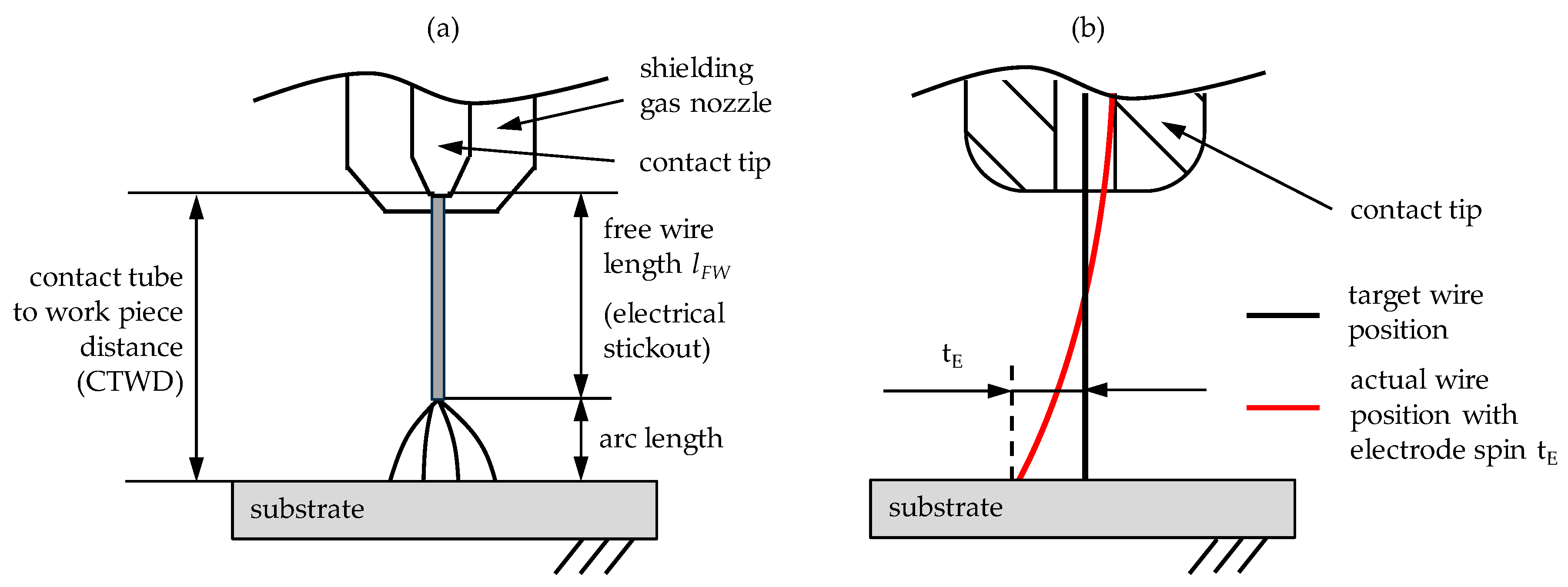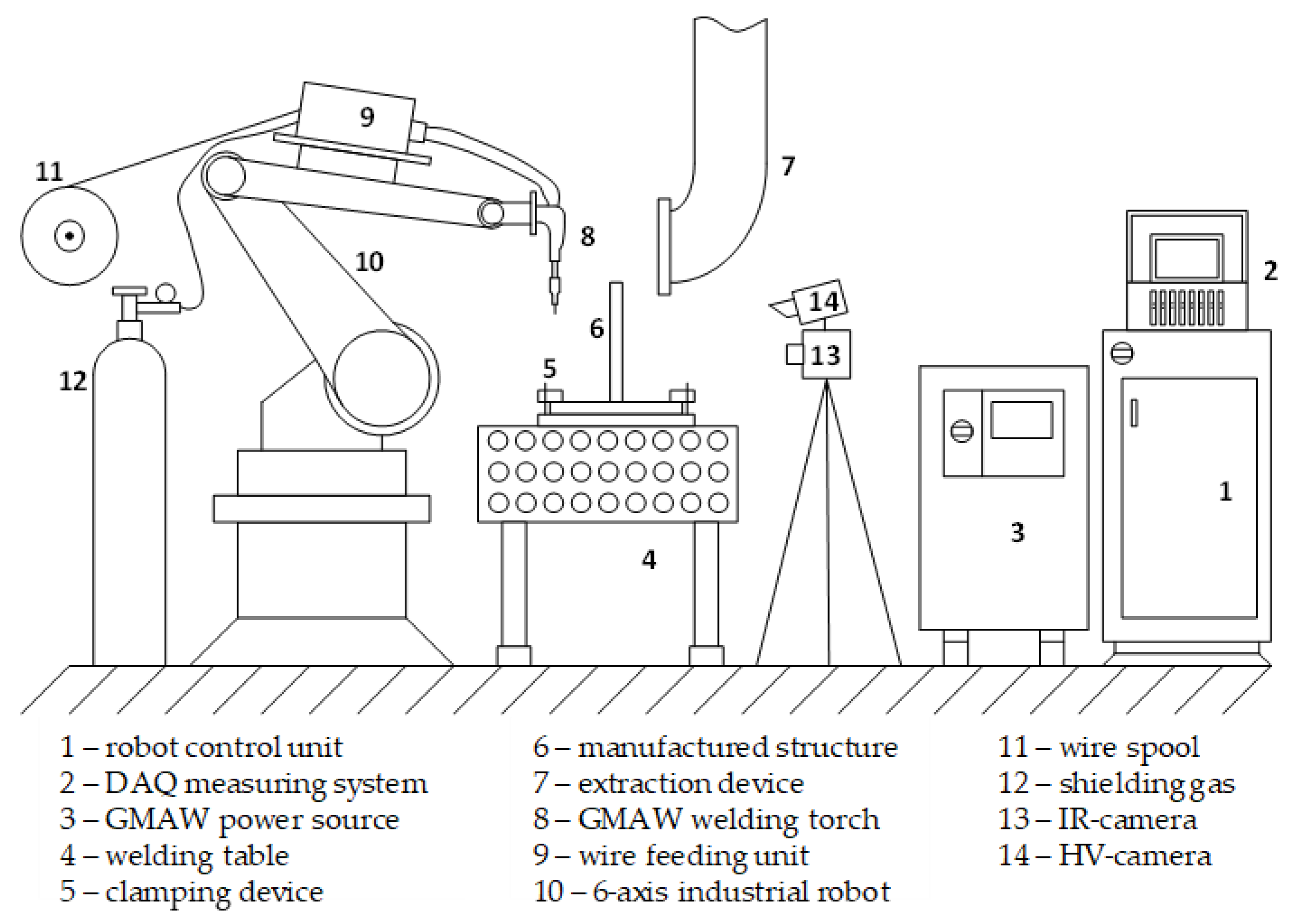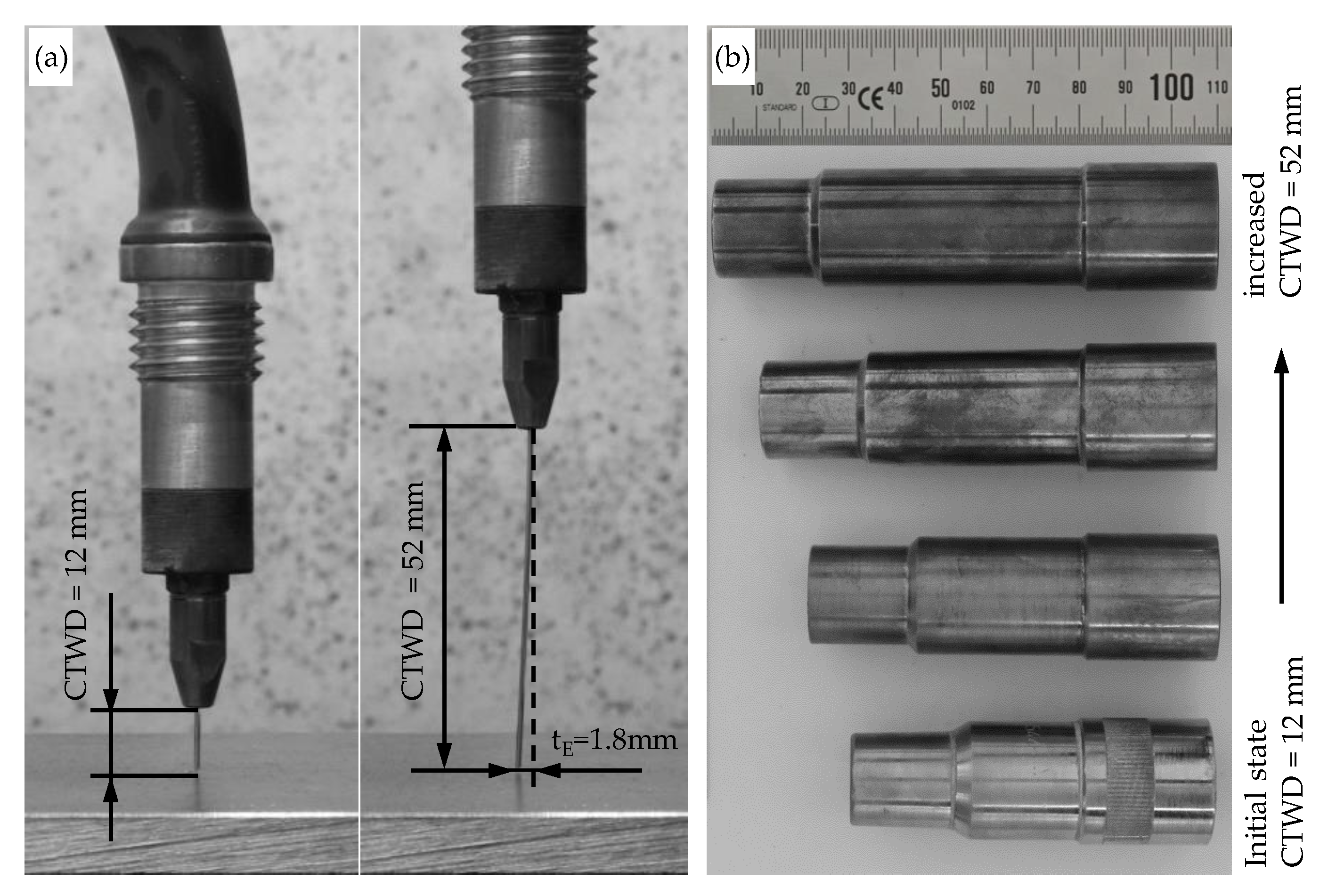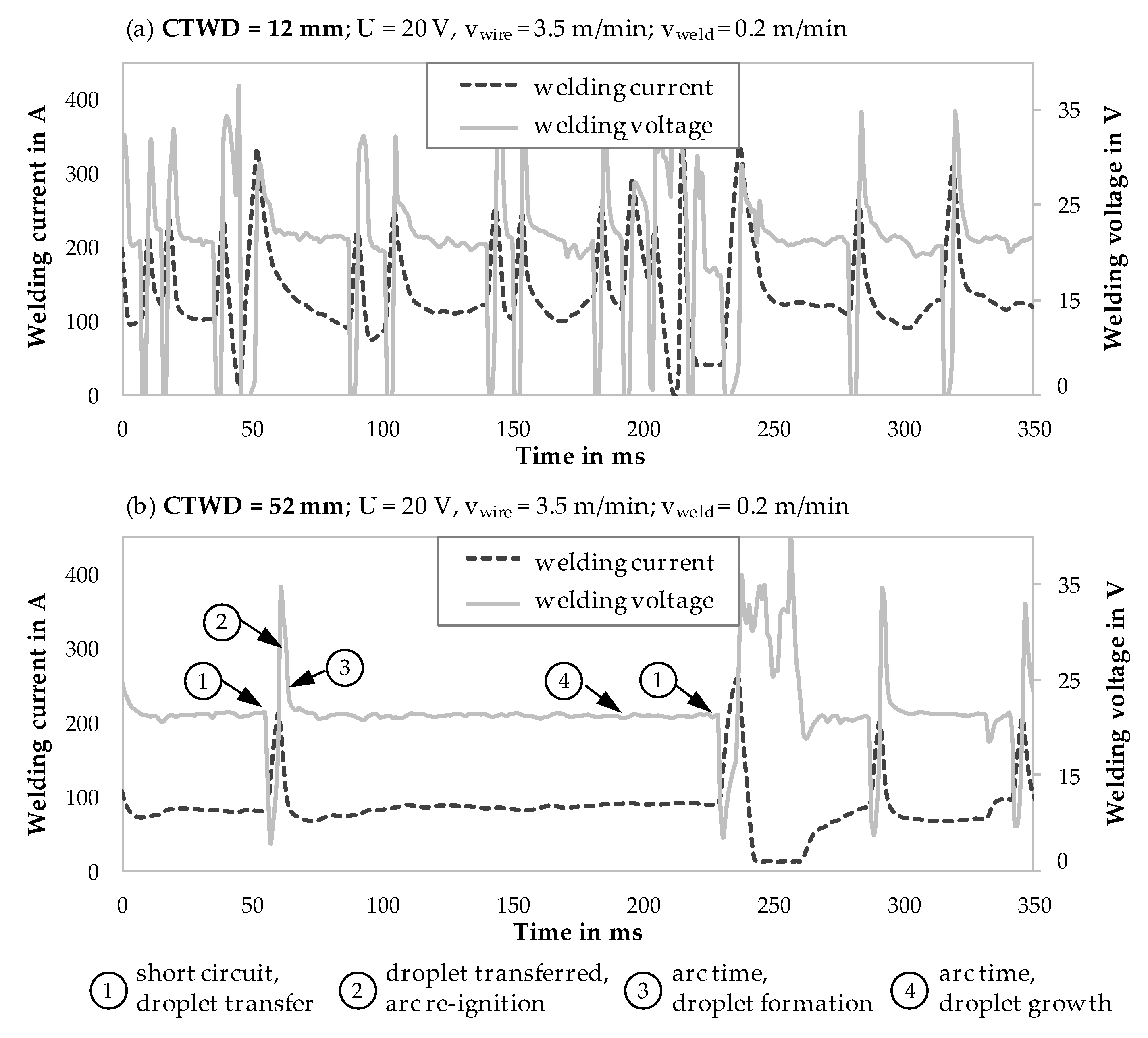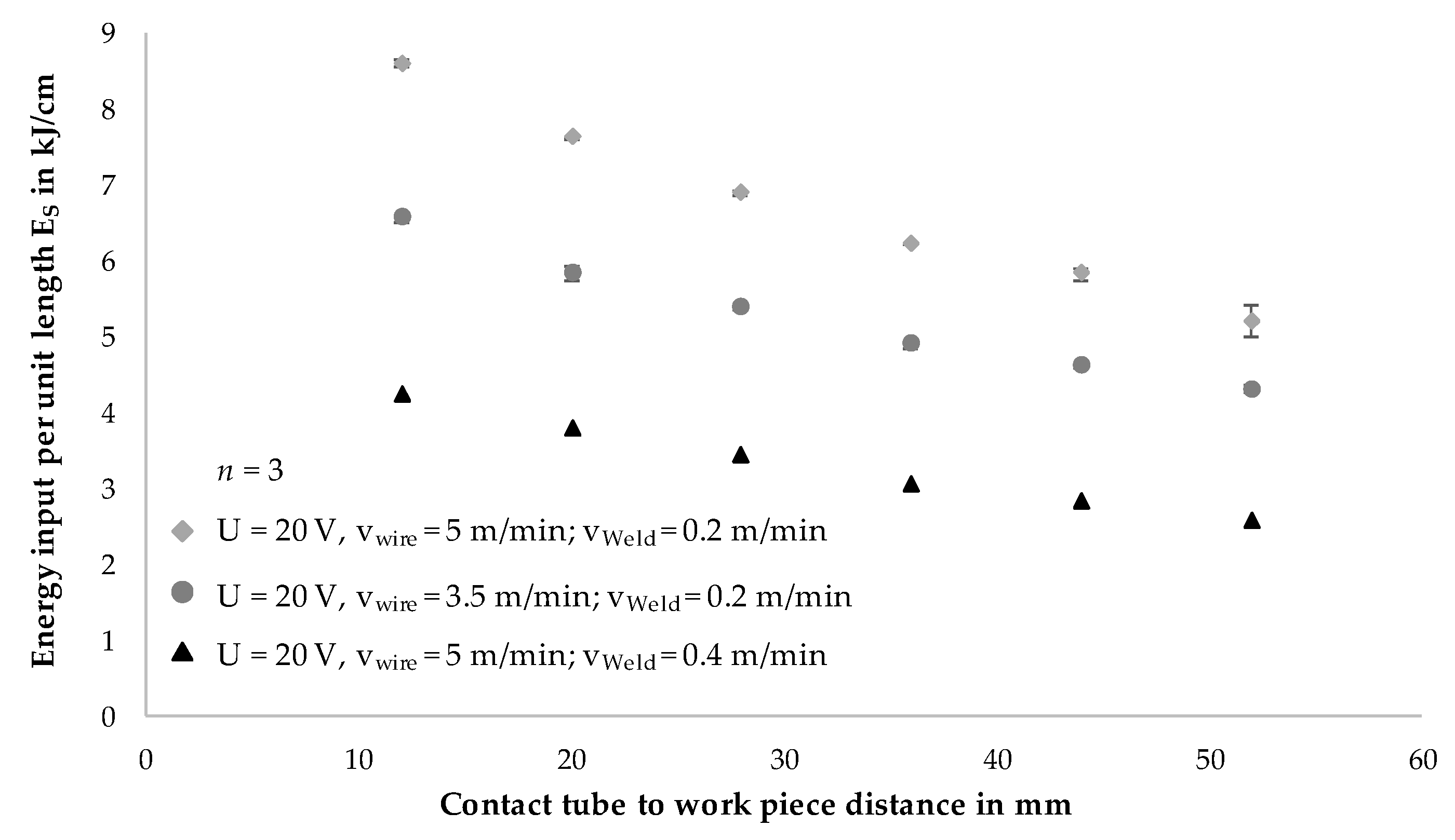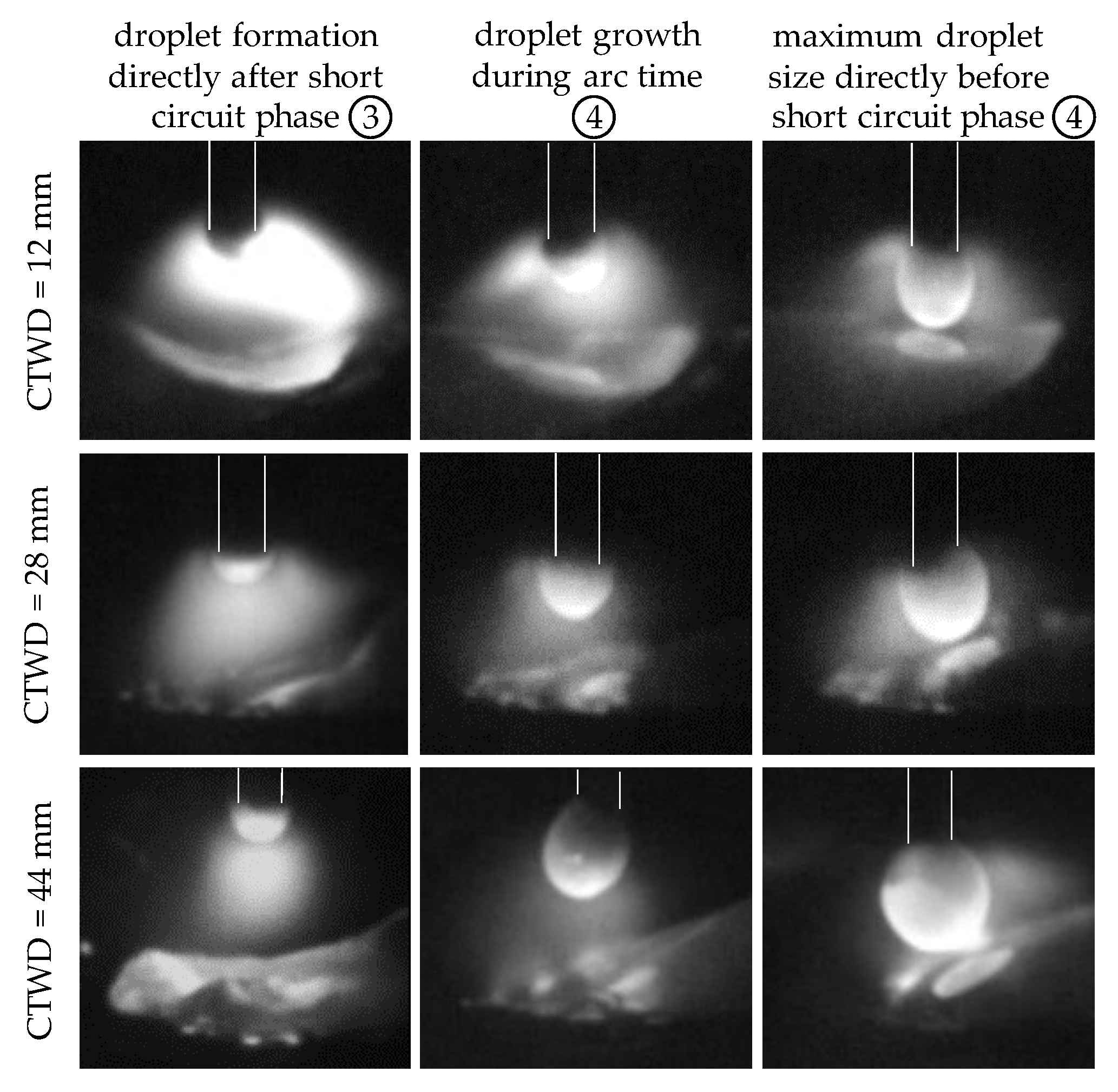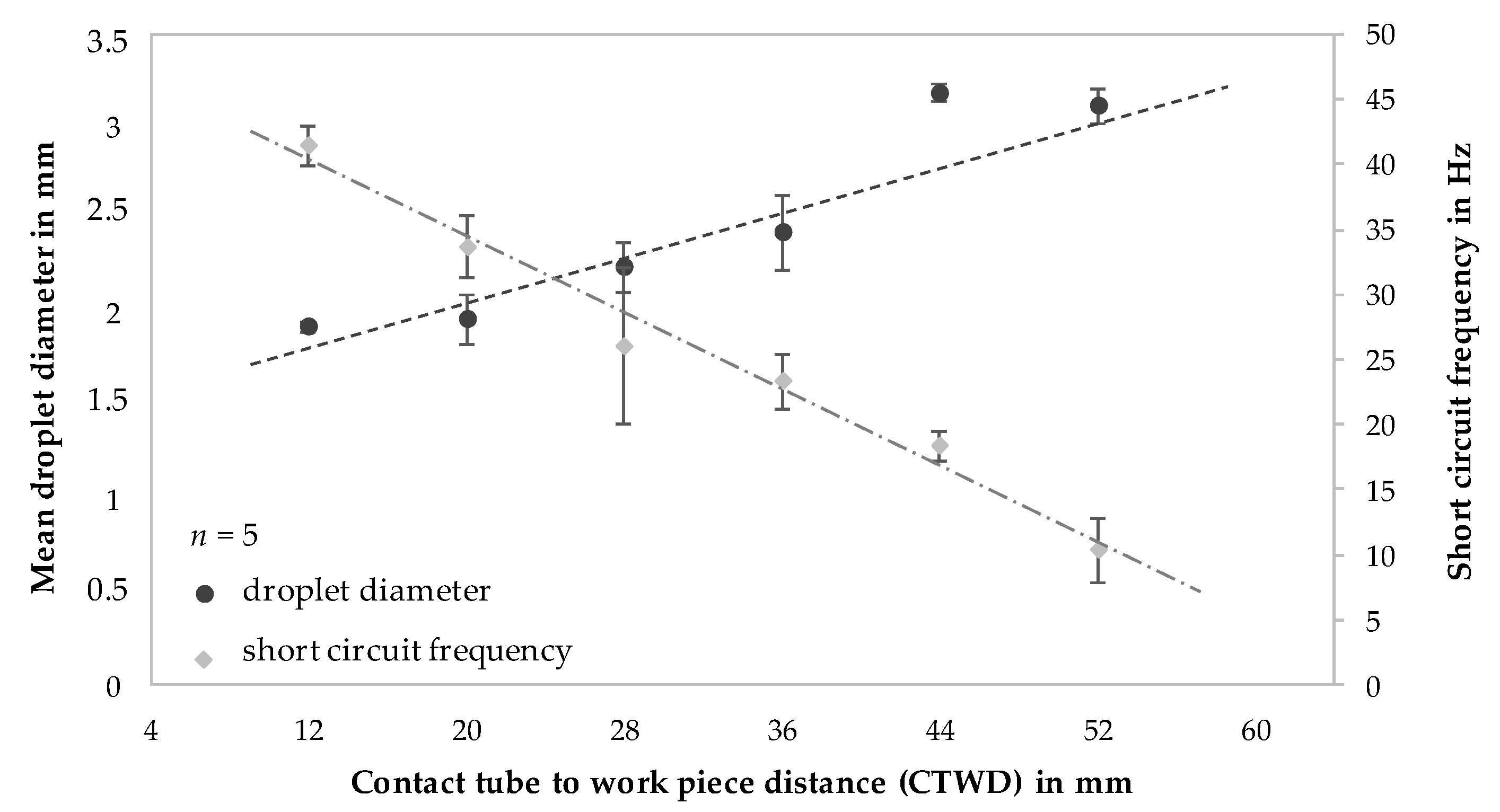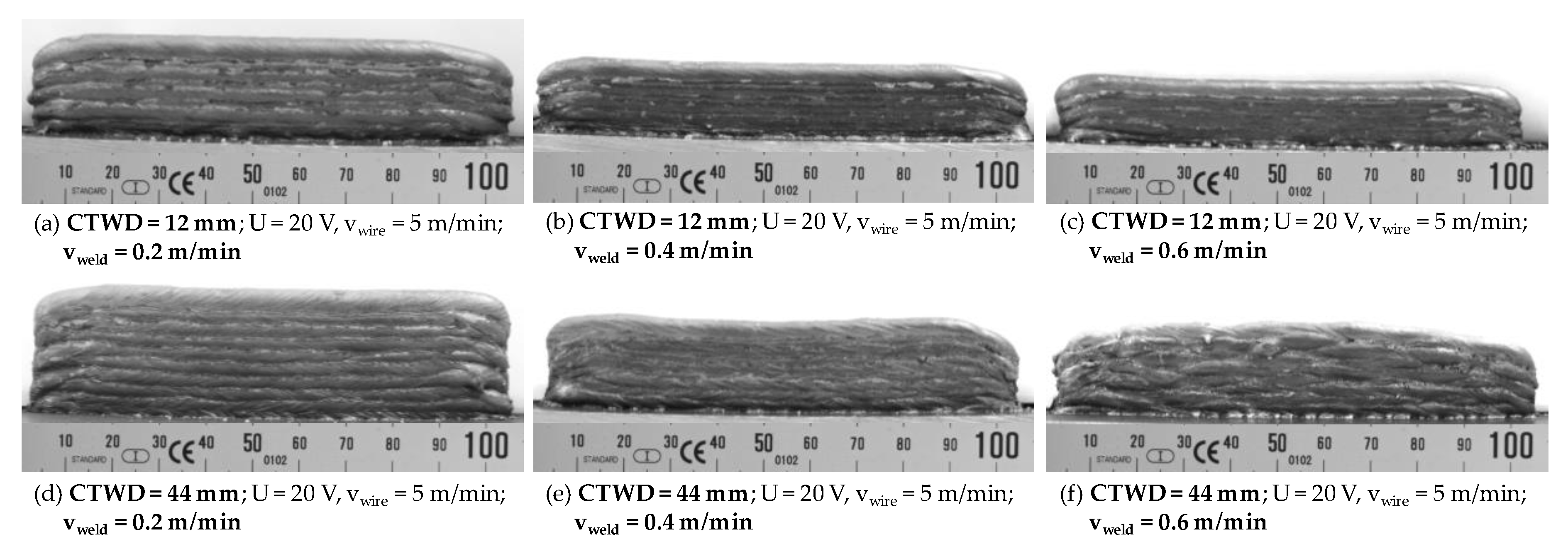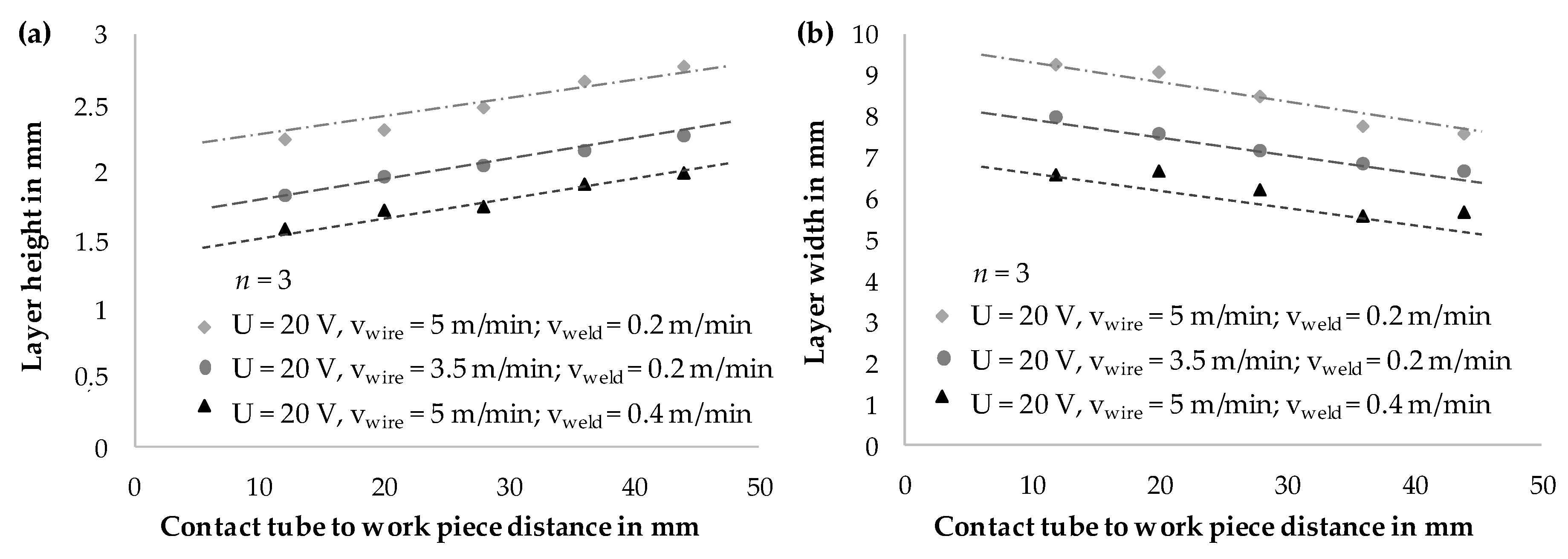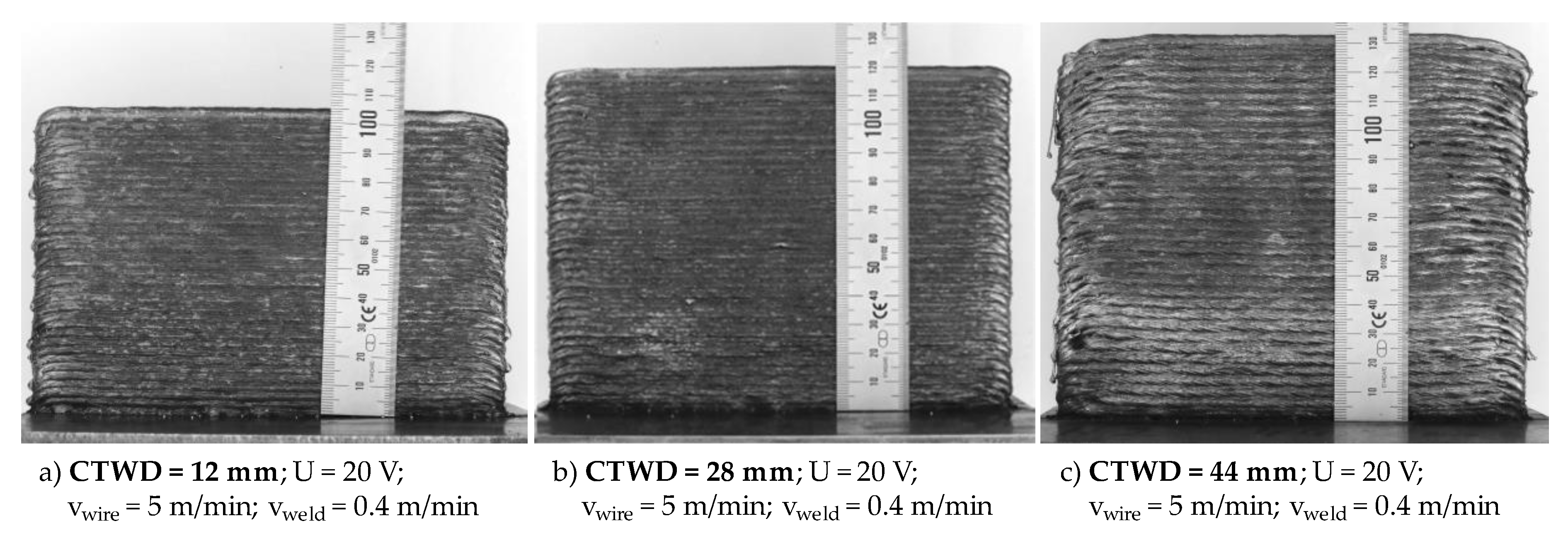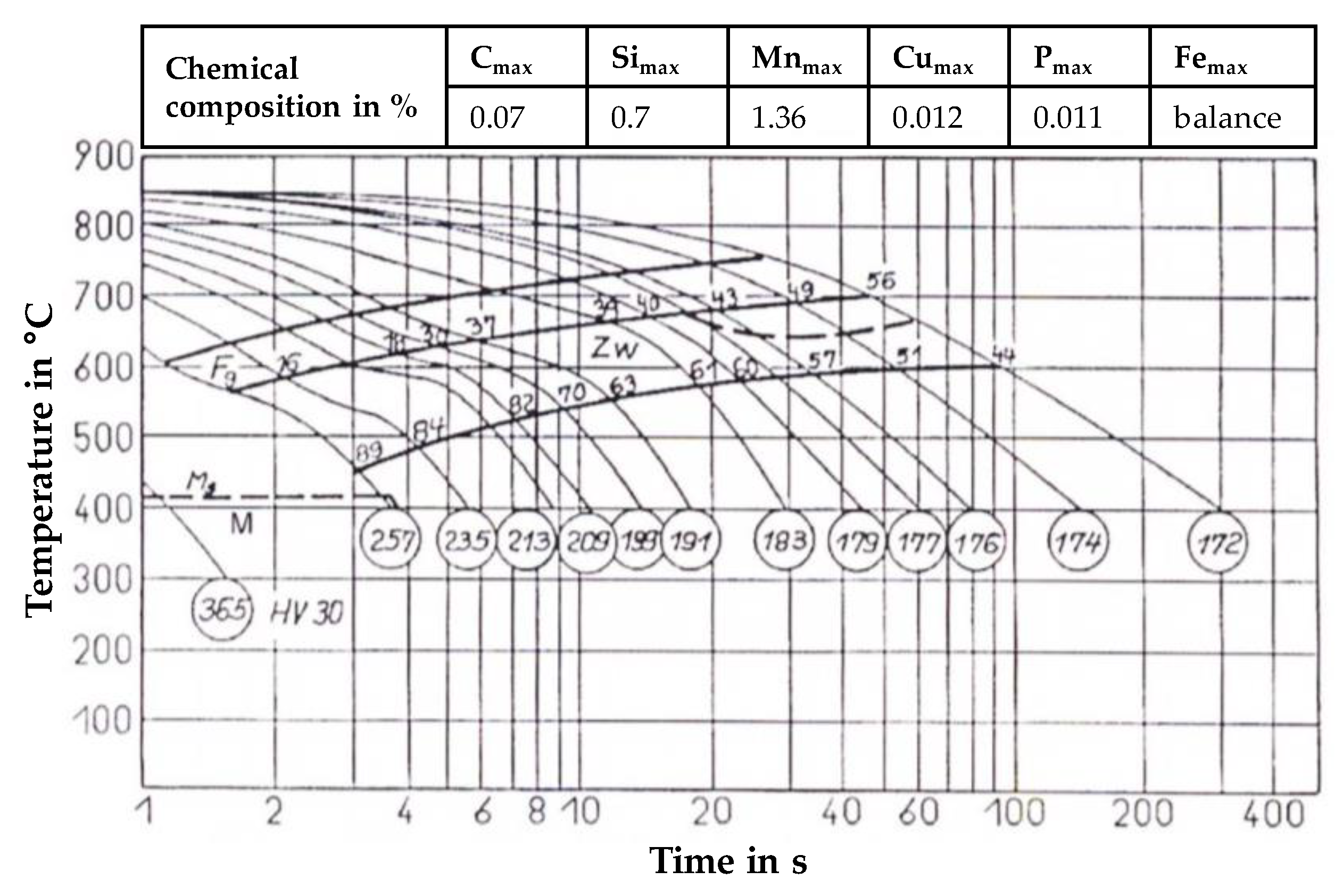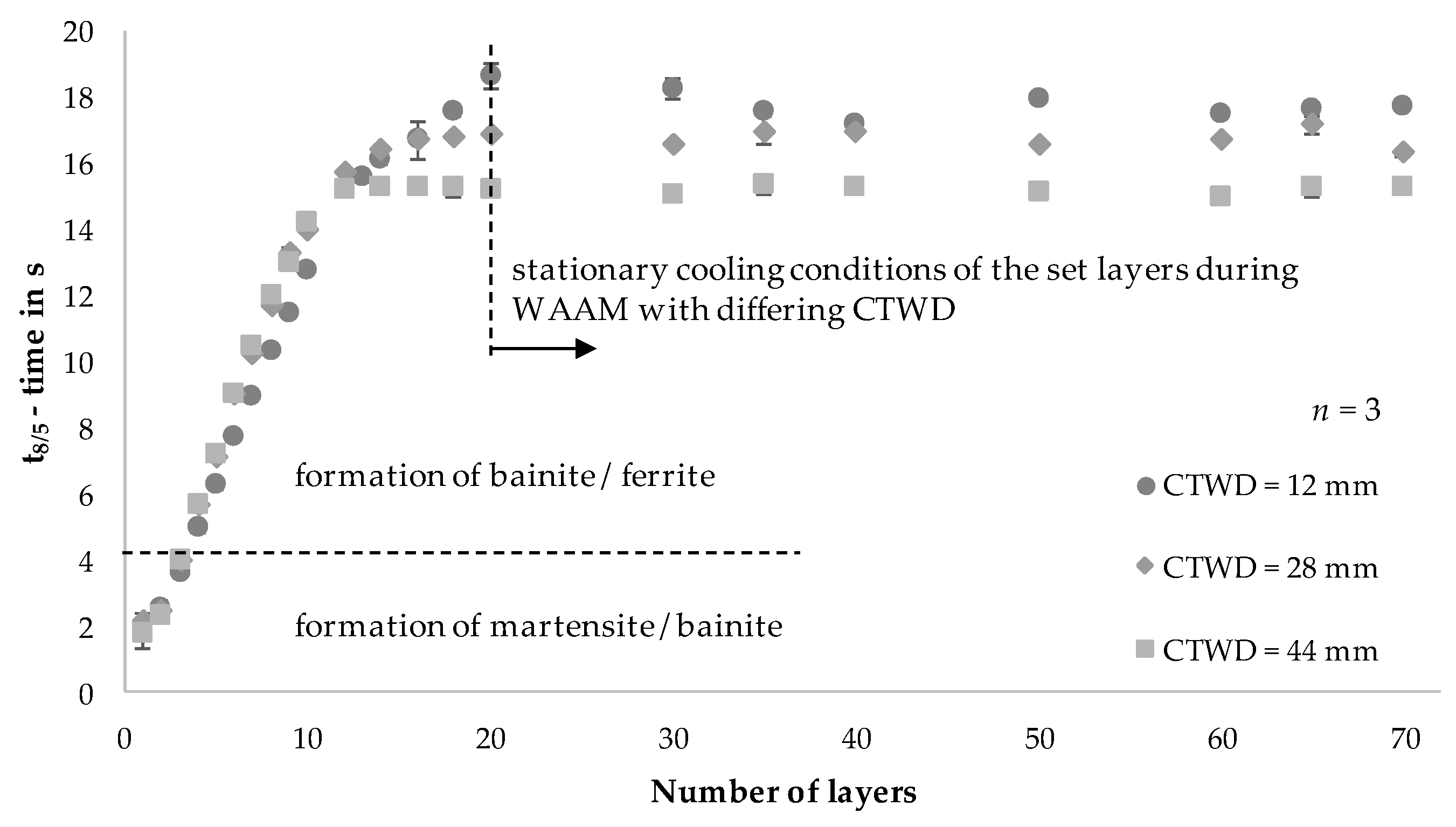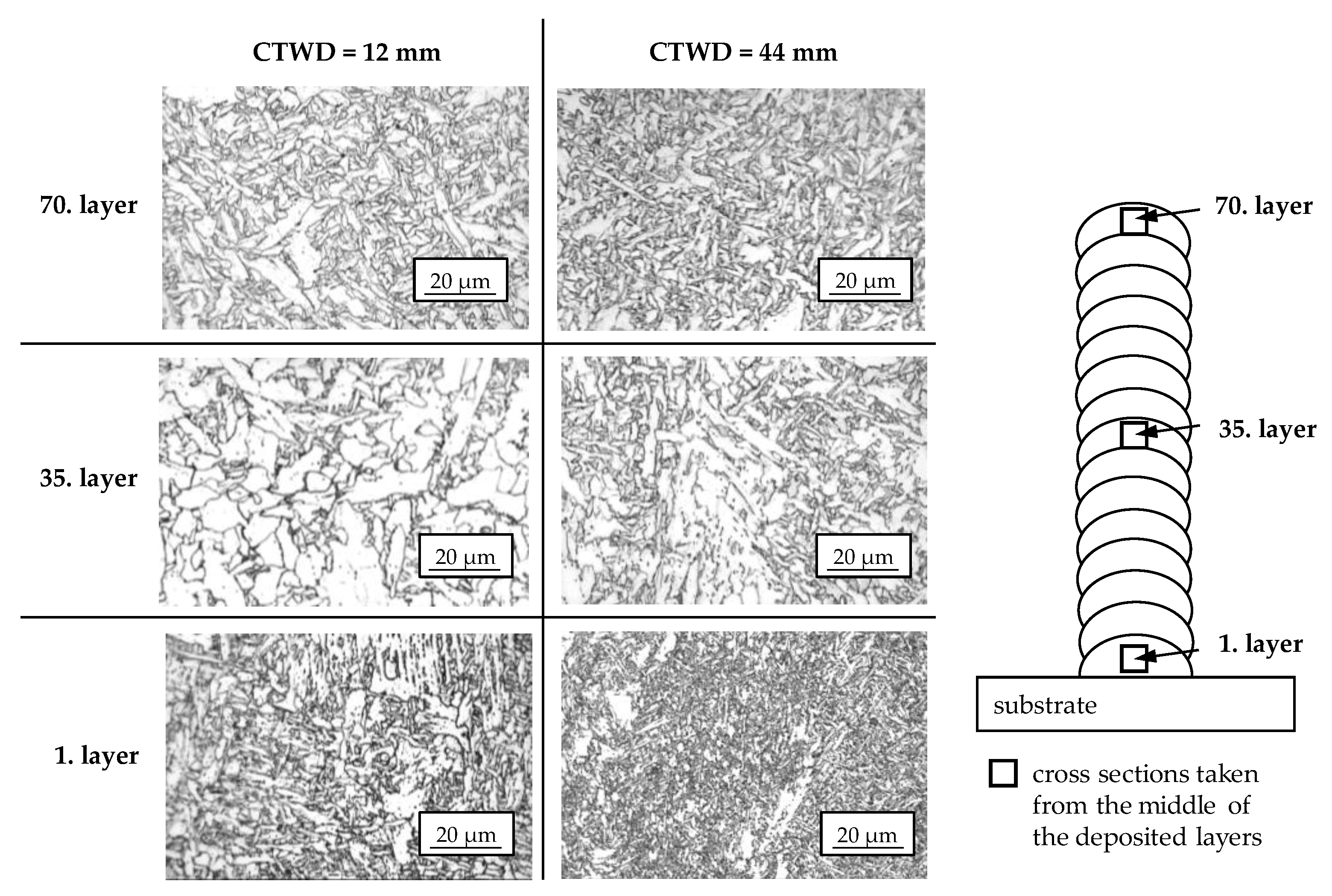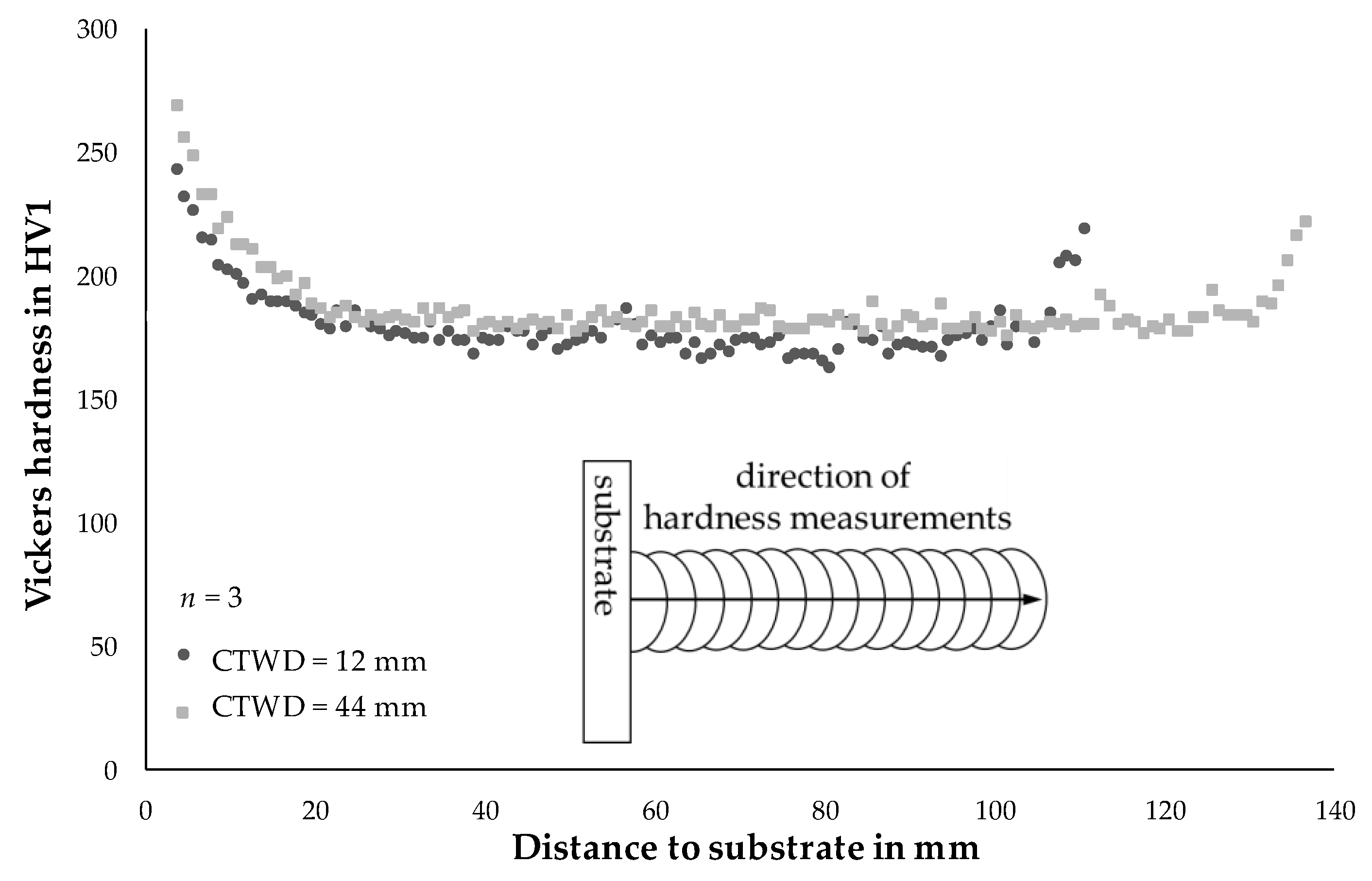4.1. Analysis of Elctrical Properties in WAAM with Increased CTWD
In the first step, electrical properties were analyzed during WAAM with a short arc welding regime to characterize the stability of the arc and short arc frequency. Welding voltage and current were measured with a rate of 1000 Hz for GMAW processes with varied CTWD from 12 to 52 mm. The following
Figure 4 shows welding current and voltage for a period of 350 ms (
Figure 4a CTWD = 12 mm;
Figure 4b CTWD = 52 mm). Furthermore, characteristic points of the electrical signals and droplet formation in short arc welding regime are exemplarily shown in
Figure 4b throughout circled numbers in the diagram.
Short circuits are characterized by deflections in welding current and voltage in relation to the base values. Herein, a rapid voltage drop with increasing current could be recognized (compare
Figure 4b, circle number 1). At this point, the molten droplet transferred from the end of the electrode into the melt bead. A material bridge between the fed wire and the melt pool occurred. After material transition the arc re-ignited. Therefore, high voltage was required, which was characterized by peaks in welding voltage (compare
Figure 4b, circle number 2). At this point, welding current dropped slowly due to inductances in the welding circuit, leading to high welding power during arc re-ignition. The subsequent period of arc time led to the melting of the electrode tip and the formation of a new droplet (compare
Figure 4b; circle number 3). Thereby, increasing arc time promoted droplet growth (compare
Figure 4b; circle number 4) before the molten material transferred into the melt bead during the next short circuit phase.
Figure 4 shows differences in short circuit frequency and uniformity of the short circuits over time with increasing CTWD. Thereby,
Figure 4a shows homogeneous droplet transfer with periodical short circuits of f = 42 Hz with a CTWD of 12 mm. Increasing CTWD leads to a reduction of the short circuit frequency (compare
Figure 4b). This can be explained by the formation of large volume droplets due to decreased welding current respectively decreased pinch force. Thus,
Figure 4b shows a short circuit frequency of f = 11 Hz with increased CTWD of 52 mm. The irregularity of the short circuit frequency arose through the formation of larger droplets (compare
Figure 4b; circle number 4), which were transferred with higher kinetic energy into the melt pool causing a wave formation of the liquid melt pool. These waves partially reached the newly forming drop at the end of the wire, creating a new short circuit. This effect caused the transfer of smaller droplets with a reduced detaching frequency during short circuit. The described effect is shown in
Figure 4b in the time window between 200 and 350 ms.
It can be shown that increased CTWD led to a reduction of droplet transfers in the short arc welding regime. Concurrently, phases of arc re-ignition with high welding power decline, leading to energy reduction induced by the welding regime and respectively the arc. As a result, the energy input per unit length
Es, as a main dimension for the characterization of arc welding processes, can be reduced with a constantly set welding velocity. Equation (5) describes the correlation between welding power
Pweld and welding velocity
vweld Herein, welding voltage
Uweld and current
Iweld can be measured directly to estimate welding power
Pweld (compare Equation (6)).
The following
Figure 5 shows the correlation of energy input per unit length
ES to the contact tube to work piece distance (CTWD) for three parameter sets. Thereby,
ES was set to values between 4.2 and 8.2 kJ/cm in the initial state of 12 mm CTWD. Increasing CTWD from 12 to 52 mm shows a steady reduction of the energy input per unit length. This relation is represented independently from the parameter set. It was evident that an increase in CTWD of 8 mm led to a reduction of energy input per unit length of 8%. A CTWD of 52 mm exhibited the maximum reduction in energy input per unit length of 40% compared to the initial state. These results correspond to the state of the art in the field of joint welding and cladding as described [
25,
31].
4.2. Analysis of Droplet Transfer in WAAM with Increased CTWD
Chapter 4.1 verified alterations in short circuit frequency with adapted CTWD throughout the analysis of electrical properties. Referring to the state of the art, increasing CTWD leads to the formation of large volume droplets during material transfer in GMAW [
25,
32]. Experimental investigations with a high velocity video recording confirmed a constant droplet growth with increasing CTWD.
Figure 6 shows droplet formation in GMAW with differing CTWD of 12 mm, 28 mm and 44 mm at characteristic points during the short arc welding regime and correlated to the circled numbers in
Figure 4b. The increase of CTWD is shown in uniform step size of 16 mm for equal welding parameters. Thereby, the formation of a new droplet on the electrode directly after short circuit phase is shown (compare
Figure 4b, circle number 3) as well as droplet growth during arc time (compare
Figure 4b, circle number 4). Furthermore, the maximum droplet size is displayed directly before the material transfer in the short circuit phase. The focus of the investigations was set to analyze droplet growth and size before material transition into the melt bead. Therefore, the short circuit phase with material transfer (compare
Figure 4b, circle number 1) and arc re-ignition (compare
Figure 4b, circle number 2) is not shown in
Figure 6.
The coupled process development of increasing droplet size and reduced short circuit frequency was caused by increasing resistance heating of the free wire length with increasing CTWD. Due to high temperatures, the extended wire softened. This effect enhanced the formation of droplets with larger material volume at the end of the wire. At the same time, the pinch effect was reduced, which was induced by the Lorentz force of the magnetic field. The reason for this is the lower welding current that affects the Lorentz force squared.
Figure 7a shows droplet formation for CTWD of 12 mm and the maximum investigated value of 52 mm (
Figure 7b) in detail. Herein, characteristic effects in the formation of the arc and the resulting droplet can be shown with differing CTWD.
Thereby, a contact tube to work piece distance of 12 mm indicates the arc attaching point at the filler wire, enclosing the formed droplet at the end of the electrode (compare
Figure 7a). At this point, the electromagnetic pinch force was applied, constricting the molten droplet. However, increasing CTWD led to a displacement of the arc attaching point to the bottom of the formed droplet (compare
Figure 7b). This resulted in a reduced pinch force to constrict the molten material, due to a decreased welding current. The formation of large volume droplets was the consequence.
The described correlation between short circuit frequency (compare
Figure 4) and droplet volume (compare
Figure 7) with systematically varied CTWD is shown in
Figure 8. To determine the mean droplet size, high-speed camera recordings were analyzed and droplet diameters measured shortly before the transition into the melt pool on five consecutive droplets. The wire width served as a reference for the measurements in the 2-dimensional images. The short circuit frequency was determined on the basis of the number of current peaks, respectively voltage drops for a period of one second during the welding process. In the short arc welding regime the number of short circuits equaled the number of droplet transfers into the melt pool.
Apparently, the short circuit frequency decreased with increasing CTWD. In the initial state of CTWD = 12 mm the short circuits occurred with a mean frequency of 42 Hz. This frequency was reduced to 11 Hz with increased distance between contact tube and substrate of 52 mm. This corresponded to 74% of the initial value. At the same time, droplet diameter increased throughout the previously described effects. The mean droplet size was determined to be 1.9 mm at 12 mm CTWD. The increase of the distance from contact tube to substrate up to 52 mm resulted in increased droplet sizes with a mean value of 3.1 mm. Thus, the average droplet size had increased by approximately 64%. During the experimental investigations, a maximum CTWD of 52 mm led to an inhomogeneous process behavior with arc deflections and excessive spatter formation. Further experimental trials were carried out with a maximum value of CTWD = 44 mm.
A side effect of decreasing short circuit frequency and respectively material transfer with large volume droplets affected the wetting behavior during GMAW. Herein, the formation of large volume droplets with low transition frequency led to a punctual wetting of the substrate. In context of WAAM, the wetting behavior was coupled to the welding velocity and was significantly relevant for the near net shape quality of the built structures. A homogeneous material transfer resulted in the formation of layers with equal geometrical properties such as width and height.
Figure 9 shows the influence of CTWD adjustment and differing welding velocities on the geometrical formation of layers during WAAM. Thereby, a CTWD of 12 mm, respectively 44 mm was adjusted with differing welding velocities of 0.2–0.6 m/min. Wall structures of 100 mm length and 10 layers were manufactured. The temperature controlled WAAM process was executed with alternating welding direction in each layer and constantly set interlayer temperature of 100 °C before the next layer was applied.
It becomes apparent, that surface quality and structure height of the work pieces were affected by CTWD adjustment as well as welding velocity. Systematical investigations on geometrical properties during WAAM with extended CTWD are shown in Chapter 4.3.
Figure 9a–c exhibited near net shaped quality for CTWD adjustment of 12 mm and welding velocities from 0.2 to 0.6 m/min. Thereby, little curvature at the structure beginning and end, an even overall height and low spatter formation were observed. In addition, high frequency of short circuits (compare
Figure 8) led to homogeneous wetting behavior and melt bead solidification. As a result, the required amount of post-processing was limited due to geometrical properties close to the final contour. Increasing welding velocity results in the formation of structures with decreased height, which could be explained by reduced material transfer per unit length at a constant wire feeding speed.
Furthermore, WAAM with increased CTWD of 44 mm and adapted welding velocity is shown in
Figure 9d–f. Thereby, the reduced short circuit frequency (compare
Figure 8) affected the wetting behavior and near net shape properties. Thus, a stable welding process and the formation of layers with equal geometrical properties could be achieved with low welding velocities up to 0.4 m/min (compare
Figure 9d,e). Thereby, surface roughness as well as the curvature at the structure beginning were slightly affected. As a result, requirements for near net shape quality in WAAM could be met with an increased CTWD of 44 mm.
Negative affection of process behavior and near net shape quality with increased CTWD is shown in
Figure 9f. Herein, the combination of the reduced frequency of droplet transfers and increased welding velocity of 0.6 m/min led to partial wetting of the previously set layers. This resulted in inhomogeneous layer geometries during the manufacturing process. Throughout these dimensional deviations in layer height, the arc ignition after the short circuit phase as well as the arc length was affected constantly. The unstable welding process was insufficient for WAAM processing. As a result, the described properties for near net shape quality could not be met.
4.3. Effects of Increased CTWD on Geometrical Layer Properties in WAAM
In gas metal arc welding, increasing CTWD led to the reduction of energy input per unit length
ES respectively heat input as described (compare
Figure 5). This had a direct effect on the formation of the weld bead geometry at a constant deposition rate. Due to lower energy input, the weld seams increased in height and decreased in width continuously. This could be described by lower temperatures in the melt pool and thus a lower viscosity of the melt, resulting in less flowable melt and faster solidification of the molten material.
Figure 10 shows experimental results for the adaptation of CTWD from 12 to 44 mm in the context of resulting layer geometries. Three parameter sets with differing energy input per unit length were chosen. Though, layer height (compare
Figure 10a) and layer width (compare
Figure 10b) were measured on three positions of a wall structure with 10 layers. The mean values are shown in
Figure 10.
The diagram in
Figure 10a shows increasing values for layer height with increasing CTWD. A rise of approximately 25% was observed independently from the parameter set. The examination of the layer width (compare
Figure 10b) exhibited an inverse dependence. Herein, layer width decreased to approximately 83% (CTWD = 44 mm) of the initial value (CTWD = 12 mm).
In the next step of the investigations, wall structures with a length of 160 mm and 70 layers were manufactured to analyze process behavior and near net shape quality on large volume work pieces.
Figure 11 exemplarily shows the resulting work pieces for a CTWD of 12 mm (compare
Figure 11a), 28 mm (compare
Figure 11b) and 44 mm (compare
Figure 11c). On these structures, microstructure and material hardness were tested additionally (compare Chapter 4.4). Therefore, the applied parameters were economically set to reduce processing time. The experimental trials were carried out with a welding velocity of 0.4 m/min, a voltage of 20 V and a wire feed of 5 m/min. The welding current as well as the energy input per unit length depend on the adjusted CTWD and varied from 4.23 (CTWD = 12 mm) to 2.82 kJ/cm (CTWD = 44 mm). The increase in CTWD from 12 to 44 mm led to a reduction of energy input per unit length of 34% (compare
Figure 5). The interlayer temperature was set to 100 °C between the deposited layers.
Figure 11 shows the resulting wall structures consisting of 70 layers. Apparently, the structures increase in height with extended CTWD as described before (compare
Figure 9). At the same time, surface roughness increased due to the described droplet diameter, transferring frequency and wetting properties. The resulting mean structure height and mean layer height are shown in
Table 2. Herein, the values for mean structure height were measured on three points of the wall structures and the values for mean layer height calculated by the division of mean structure height by the total number of layers. Furthermore, the results were compared to preliminary manufactured wall structures with 10 layers (compare
Figure 10). The deviation is also shown in
Table 2. A CTWD of 12 mm results in a structure height of approximately 107 mm, respectively a mean layer height of 1.53 mm (compare
Table 2). Increased CTWD of 44 mm led to a structure height of approximately 134 mm (1.92 mm layer height), which was an increase of 25%. Little deviations < 5% compared to structures in preliminary investigations confirmed process stability and the effects of increasing CTWD on geometrical layer properties on large-volume structures.
The side effect of adapted layer geometries was significant for the use of increased CTWD during WAAM. The change of the weld bead geometry at constant welding voltage, constant welding speed and constant wire feed has to be taken into account for path planning strategies. Especially if the value of the contact tube to work piece distance is set dynamically in the WAAM process to adapt the layer height or width.
4.4. Effects of Increased CTWD on Microstructure Development in WAAM
In wire arc additive manufacturing, the adjustment of energy input affects the cooling conditions and moreover metallurgical properties of the metallic work piece. Though, microstructure and mechanical properties can be influenced. A common approach to characterize un- and low-alloyed steel during welding is the estimation of the t
8/5-time according to DIN EN 1011-2:2001-05 [
36]. This describes the time interval of cooling of the weld bead and the heat-affected zone (HAZ) from 800 to 500 °C. In this temperature range, phase transformations from γ- to α-phase take place, which are decisive for the mechanical-technological properties. Therefore, a continuous cooling transformation (CCT) diagram can be used to estimate microstructure and mechanical properties in dependence on the chemical composition and occurring cooling rates. Since no diagram of the applied filler material is available from the manufacturer, a CCT-diagram of steel with a chemical composition as similar as possible was used.
Figure 12 shows the CCT-diagram of the low-alloyed steel SG36 as well as the chemical composition [
37]. Furthermore, phase formation at different cooling rates and expectable hardness values are shown. Though, minor deviations in silicon and manganese content of approximately 0.3% can be seen. Due to this, slight deviations in phase proportions and hardness in comparison to the used filler wire G4Si1/SG3 may occur.
The filler material is a hypo-eutectoid steel with a low carbon content of C ≤ 0.07% and increased percentage of silicon and manganese. Thus, almost no pearlite was formed during cooling (compare
Figure 12). The microstructure was mainly composed of different proportions of intermediate structure (bainite) and ferrite at moderate cooling rates. At very high cooling rates, e.g., in the first weld bead, martensite formed.
To correlate process adaptations and resulting metallurgical properties of the previously built structures (compare
Figure 11), cooling rates of the set layers were analyzed during WAAM with adapted CTWD. Therefore, t
8/5-times were recorded layer wise by IR imaging. The analysis was carried out on each of the first 10 layers due to strongly varying cooling rates. This can be explained by heat conduction to the substrate, which featured room temperature in the initial state. As a result, an increasing number of layers led to heat accumulation and rising temperatures in the substrate until a quasi-stationary condition of heat input and heat transfer was reached. During the manufacturing of the following 10 layers, measurements were carried out in every second layer. Finally, every 10th layer was recorded with the exception of layer 35, which is the center of the structure.
Figure 13 shows the resulting t
8/5-times during WAAM depending on the layer height and the set CTWD.
The measured t
8/5-times in the 1st weld bead of approximately 2 s show small deviations between the experimental trials with adjusted CTWD. According to the CCT-diagram, the formation of a martensitic-bainitic microstructure with high hardness values > 257 HV appeared for t
8/5-times up to 4 s. These cooling conditions were measured from the first to the third layer (compare
Figure 12). With increasing structure height and thus longer t
8/5-times, the microstructure consisted of varying proportions of bainite and ferrite (compare
Figure 13). The expectable hardness decreased.
Between the 4th and 10th layer, the t
8/5-times for a CTWD of 12 mm were slightly lower of approximately t
8/5 = 1.5 s in comparison to a CTWD of 28 mm, respectively 44 mm. This development is controversial to the process behavior and reduced energy input per unit length with increasing CTWD. The reason for the opposite development is the fact that the weld bead geometry and thus the conditions of heat conduction to the substrate change with increasing contact tube distance. The width of the weld bead (compare
Figure 10b) decreased by approximately 0.6 mm (CTWD = 28 mm) or 0.9 mm (CTWD = 44 mm) and consequently also the effective area for heat conduction. The effect of thermal conduction is the essential driver of heat transfer close to the substrate. This observation is consistent with the research of Cunningham et al. [
7].
From the 12th layer on, the resulting t
8/5-times adjusted to an increasingly stationary state between 15 and 20 s. This can be explained by the low amount of introduced thermal energy and the resulting lower temperature gradients between the structure and the substrate. As a result, stationary cooling conditions of the set layers can be observed. Herein, a difference in the t
8/5-time of approximately 2.5 s results for the different CTWD adjustments. A correlation between the energy input per unit length (compare
Figure 5) and the resulting cooling rates (compare
Figure 13) can be shown throughout decreasing t
8/5-times at reduced energy input. According to the CCT-diagram [
37], a microstructural composition of 63% bainite and 37% ferrite occurred for t
8/5-times between 15 to 20 s with hardness values below 191 HV.
Table 3 shows the estimated phase formation and hardness values for the 1st, 35th and 70th layer. It should be noted that a CCT-diagram [
37], which is designed for a chemically comparable steel was used. Due to this, slight deviations of the theoretical values to the experimentally measured values have to be taken into account.
In the next step, microstructural cross sections of the previously built wall structures with varied CTWD of 12 mm and 44 mm were taken from the middle of the 1st, 35th and 70th layer. Herein, microstructural evolution of low-alloyed steel G4Si1/SG3 is shown in dependence on differing cooling conditions during WAAM. The cross sections are shown in
Figure 14.
In the cross sections of the 1st layer, a primarily bainitic structure with accumulations of ferrite grains is apparent for a CTWD of 12 mm and 44 mm. According to Seyffarth et al. [
37], martensitic phase can be seen in addition to the bainitic microstructure due to t
8/5-times < 2 s in the first layer. With increasing CTWD of 44 mm, the microstructure becomes fine grained, although the measured cooling rates were equal. This phenomenon can be explained by lower energy input with increasing CTWD (compare
Figure 5). Thereby, lower heat input resulted in decreased grain growth as well as decreased dilution between filler material and substrate.
The cross sections of the 35th layer show a microstructural composition of coarse-grained ferrite with embedded globular bainite for a CTWD of 12 mm. An increased CTWD of 44 mm led to a reduced grain size. This correlated to the decreased energy input per unit length (compare
Figure 5) and reduced t
8/5-times in the center of the structure (compare
Figure 13). Furthermore, a periodical reheating of the bead throughout the following layers enhanced grain growth. In the 70th layer a bainitic-ferritic structure is visible, independently from the adjusted CTWD. This corresponds to the state of the art [
37]. The fine grained microstructure can be explained by a lack of post-weld heat treatment in the last layer of the WAAM process. Further heat input throughout a following layer is not present.
Throughout microstructural testing, no structural defects such as a lack of fusion (compare
Figure 11) or porosity could be found. Herein, low energy input per unit length (compare
Figure 5) led to the formation of small and stable melt beads with enhanced decarburization. Furthermore, the increased silicon content of 1.0% (compare
Table 1) in the filler wire provided enhanced binding of oxygen during solidification.
The verification of microstructural phases was carried out by hardness measurements on the wall structures described in Chapter 4.3. Therefore, Vickers hardness testing was conducted from the substrate to the top layer in build-up direction of the work pieces.
Figure 15 shows the resulting mean values of three parallel measuring rows per structure for Vickers hardness testing with a distance of 1 mm between the measuring points.
A CTWD of 44 mm led to mean hardness values of 271 HV1 in the 1st layer, which was approximately 30 HV1 higher than the mean hardness value at 12 mm CTWD in the same position. According to the CCT-diagram of the unalloyed steel, martensitic phase exceeds hardness values of 257 HV1 [
37] and can be shown for a CTWD of 44 mm. Despite equal t
8/5-times between 12 and 44 mm CTWD, this can be explained by reduced heat input and less dilution between filler material and substrate. As a result, a fine grained microstructure (CTWD = 44 mm) led to increased hardness. Moreover, the slightly different chemical composition of the filler wire to the used CCT-diagram must be considered. Increasing percentage of silicon and manganese of approximately 0.3% might affect martensite start temperature as well as phase fraction.
With increasing number of layers, the difference in hardness becomes smaller. From a distance to the substrate of approximately 20 mm a mean hardness of 180 HV1 can be observed for a CTWD of 44 mm. A decreased CTWD of 12 mm led to mean hardness values of approximately 168 HV1. These values can be measured with little deviation throughout the additively manufactured structure to a distance from the substrate of 102 mm (CTWD = 12 mm) respectively 126 mm (CTWD = 44 mm). The values correspond to the shown cross sections of the 35th layer (compare
Figure 12) and verify the presence of ferritic phase with proportions of bainite according to the CCT-diagram [
37].
Independently from the set CTWD an increase in hardness can be seen in the last layers of the structures up to 220 HV1 (compare
Figure 15). This refers to a lack of post-heat treatment in the last layers and a fine-grained microstructure.
